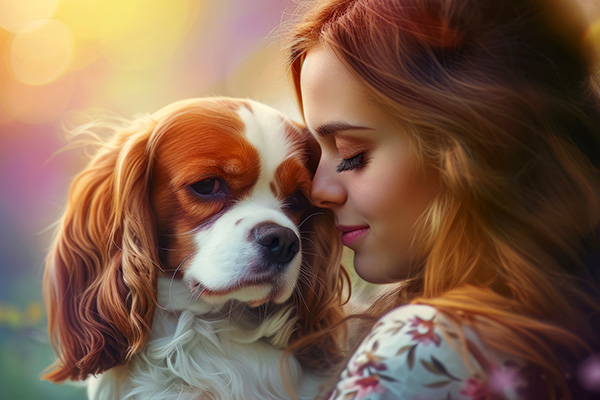Tuning In To The Psychic Wisdom Of Animals
 Animals are remarkably attuned to our moods. They can sense the vibrations of our thoughts and emotions before we even speak. Their psychic sensitivity defies logic and reaches into the realm of the mystical.
Animals are remarkably attuned to our moods. They can sense the vibrations of our thoughts and emotions before we even speak. Their psychic sensitivity defies logic and reaches into the realm of the mystical.
I’ve always been aware that animals can see into our hearts and minds in ways we humans have long forgotten. There’s a quiet, knowing wisdom in their eyes. They show a depth of understanding that suggests they perceive far more than we realize.
People across many cultures and spiritual paths believe that animals come into our lives to teach, guide, and inspire us. They reflect our energy, test our patience, demonstrate unconditional love, and remind us to stay present.
When viewed this way, our connection with animals feels like a sacred soul agreement where both parties grow and learn together.
This concept is also found in spirit animal or totem traditions, which are part of many Indigenous and shamanic teachings.
In these practices, each animal represents a specific type of wisdom or lesson that aligns with something we need to learn. Observing how animals behave or taking note of which ones appear in our dreams can reveal messages intended just for us. These connections help us discover who we really are and remind us that we’re all connected.
In Buddhism, especially the Mahayana tradition, there is a belief that all living beings, including animals, are caught in the cycle of rebirth. This belief fosters deep compassion because any animal could have once been a loved one from a past life. Witnessing animal suffering can open our hearts even more. Animals also teach us how to be mindful. They live in the present moment without attachment or worry. By caring for them with kindness, we grow spiritually and let go of some of our ego.
Animals can communicate quite well. And they do. And generally speaking, they are ignored ~ Alice Walker
Hinduism also teaches that all life is connected. Like humans, animals are on a journey through many lifetimes. Many Hindu gods have sacred animals called vahanas. They are spiritual companions that carry deep meaning. Nandi the bull, for instance, symbolizes devotion, and Ganesha’s mouse represents the mind that needs to be quieted. The principle of ahimsa, or nonviolence, encourages us to treat all creatures with love and respect. This approach supports our own inner peace and growth.
Esoteric traditions such as Theosophy and Anthroposophy offer a different yet equally beautiful perspective. They teach that, unlike humans, animals don’t have separate, individual souls. Instead, they belong to “group souls” shared among their species. These group souls reflect different stages of spiritual evolution. By observing animals and recognizing patterns in their behavior, we can learn a great deal about ourselves. These traditions also say that how we treat animals can shape our own path of growth because we’re all evolving together.
Although animals don’t use words the way we do, they communicate in powerful ways. They send feelings, images, and thoughts directly through what many call telepathy. This kind of connection comes naturally to them. They don’t question or explain it; they just do it. Their senses are so acute that they pick up on things we often miss. This quiet, heart-to-heart understanding reminds us just how deep our bond with them truly is.
Rupert Sheldrake, a British biologist, has spent years studying the idea that animals might have telepathic abilities. He’s especially interested in how cats and dogs seem to know when their owners are coming home, even when there’s no clear reason they should.
In his book Dogs That Know When Their Owners Are Coming Home, Sheldrake shares many real-life stories of pets showing this kind of behavior. One well-known example is a dog named Jaytee, who would go to the door and wait at the exact time his owner started heading home, even when the return time changed randomly.
Sheldrake also looked into other animals, like an African Grey parrot named Nkisi, who seemed to react to what its owner was thinking. He believes telepathy is natural, not something paranormal, and may have developed as a way for animals to stay connected within their social groups.
They move finished and complete, gifted with extensions of the senses we have lost or never attained, living by voices we shall never hear ~ Ed Yong
Consider, for example, the way animals react to danger. There’s no logical reasoning behind a deer freezing in the headlights of a car or a cat fleeing from a vacuum cleaner. They aren’t analyzing the situation; they’re instantly overwhelmed by the sensory input, and their response is pure instinct. This very instinct allows them to tap into the energy around them. They feel before they think.
I saw this all the time with my Husky mix. She panicked immediately when she heard fireworks. Her reaction was immediate and visceral. If we weren’t careful to keep her inside, she would bolt at the sound of those booming bangs. To her, they must have fely like an attack from the heavens. Loud, unpredictable, and terrifying.
When she got like that, I learned not to say things like “Don’t be scared; it won’t hurt you.” Animals don’t register the words “don’t” or “won’t” the way we do. They latch onto emotional keywords: “scared” and “hurt.”
Rather than soothe her with words that might inadvertently reinforce her fear, I tied to project calm energy. I visualized her feeling safe, warm, and secure. I imagined her curled up in her bed, at peace. I focus on the feeling of safety and speak in affirming tones: “You are safe. It’s quiet inside. You are protected.”
This subtle shift makes a big difference. Animals tune in to our emotional broadcasts. If we send out calming energy and intentional thoughts, they can clearly receive that message.
When I offer readings I sometimes help clients connect with their pets, whether they are living or deceased. Yet, when it comes to my own pets, I prefer to seek the help of a trusted specialist. There’s something deeply reassuring about having an experienced animal communicator or “pet psychic” confirm what I already feel in my heart.
When my beloved Rottweilers passed away several years ago, I was devastated. But during a reading with a respected communicator, she conveyed the unique quirks and nuances of my girls and the little traits that only I would know. It brought me immense comfort to feel that their spirits were still with me, watching, guiding, and loving from beyond the veil.
We need another and a wiser and perhaps a more mystical concept of animals… In a world older and more complete than ours they move finished and complete, gifted with extensions of the senses we have lost or never attained, living by voices we shall never hear ~ Henry Beston
Animal communication isn’t limited to our pets. It works with wild animals, too. I’ve been heartened to see more TV programs and documentaries highlighting the work of animal communicators in rehabilitation efforts. You can see the shift in a traumatized animal’s eyes when they are truly heard and understood. Some of these transformations are nothing short of miraculous. Witnessing a once fearful and aggressive creature soften into trust is to witness the power of true soul connection.
So, how can we support our animal companions on their journey? First and foremost, we love them. We honor their presence in our lives, recognizing that their spirits are just as important and evolved as our own. I once read that the love we give our animals helps them evolve on their sacred journey, just as their love helps us evolve on ours. It’s a reciprocal bond rooted in ancient soul agreements and spiritual purpose.
One day, we may understand just how intricately connected we all are. Humans, animals, the Earth, and the stars. Until then, we must continue to trust. We speak heart-to-heart with our animal companions, knowing the language of love and spirit needs no words.
If you feel your pet is trying to tell you something, they probably are. Sit in stillness. Open your heart. Send them a thought, an image, or a feeling. Then wait. Listen. They’ll respond in their own way. After all, they’ve always been listening.
|
|

Leave a Reply